garden folk the mag

Keeping the Community Inspired







Happy Spring!…well almost! While it may well be spring according to the calendar, that hasn’t stopped the rain, wind and in some places, a blanket of snow. April is a busy month for seed sowing, pricking out and potting on, so make sure you have plenty of ways to protect young plants from late frosts.
We hope you have had the chance to look through the new Garden Folk Magazine website. It was a huge moment to release the site where you can meet the team, the writers, scroll through all editions of the magazine, contact us and learn how you can support the community magazine. Don’t forget to go check it out at: www.gardenfolkmag.com .
In this month’s magazine there are lots of tips for what to do in April to get your garden in tip top shapes. However, don’t forget, in amongst one of the busiest time of year for gardeners, to enjoy the fun of gardening and not to worry if some seeds don’t get sown. Everything will come together and our gardens will be buzzing again very soon. Enjoy being outside, seed sowing, getting soil on your hands, and absorbing your dose of vitamin D.
Photo Credit: Ellen Mary Webster
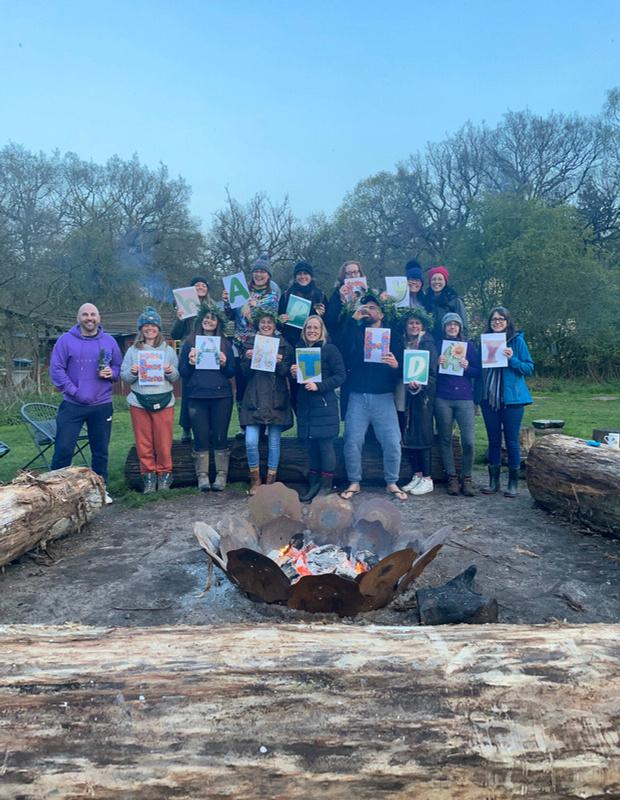
April is ‘Earth Month’, although let’s face it, every month should be earth month. ‘Earth Month’ began in 1990 when over 200 million people from over 140 countries joined together to create the movement. It is now one of the most well known and important month long movements in the whole world! As part of the month, there is also ‘Earth Day’, which this year is on 22nd April. The first ‘Earth Day’ was back in 1970 in the US, where again, millions of people joined the environmental movement.
The month is all about raising awareness and getting involved in initiatives to help save the planet from the devastating effects of climate change. ‘Earth Day’ on 22nd April has a theme each year and for 2024 it is Planet vs. Plastics and is encouraging everyone to stop using single use plastics. As part of this, earthday.org is also campaigning for a 60% reduction in the production of all plastics by 2040.
Photo Credit: Ellen Mary WebsterHow can you get involved?
As per the Earthday website:
Eliminating single-use plastics: Say no to straws, plastic bags, utensils, and water bottles
Recycling and composting responsibly: To reduce the amount of garbage that ends up in landfills, make sure that acceptable plastics are recycled and food scraps are composted
Embracing reusable alternatives: Invest in reusable shopping bags, food containers, coffee mugs, and water bottles.
Advocating for policy change: Make sure your representatives are aware of the issue of plastic pollution and encourage them to take action.
Supporting sustainable businesses: Select companies that are dedicated to cutting back on plastic usage and making use of recyclable resources.


What can we do in the garden to help?
It can be overwhelming to think about all of the things needed to help the planet but we know that every little bit helps and it’s ok not do it perfectly Do whatever you can, and that will go a really long way As gardeners, we are connected to the natural world all year round as we replenish soil, sow seeds, nurture plants and take note of the weather and there are loads of ways to help through climate friendly practices in our growing spaces
Go Plastic Free: there are many garden alternatives to plastic now From coir pots and modules to rubber seed cells, paper and bamboo pots and of course recycling your own food containers, toilet roll inserts and making your own paper seed pots, there are so many ways to sow seeds than using the old thin plastic cells If you do have them, just try to use them as many times as possible and look for where they can be recycled Some garden centres and supermarkets will take plastic to be recycled depending on what type it is.
Plant Trees: it seems so obvious, yet we still need to keep planting more trees. The important part here is that it needs to be the right tree for the right place with the right maintenance but in your own garden thats easy to do! Even in a small space, some trees can be grown in large containers, even on a balcony. Think about your space and the mature size of the tree and see if it fits in your garden. Native hedging is also a great option for gardens which will support wildlife and can even filter out pollution (or perhaps neighbours)!
Photo Credit: Ellen Mary Webster Photo Credit: Ellen Mary Webster



No Diggity: Once you have the song in your mind, thats your ear worm for the day! No dig improves soil structure and is generally good for the garden, plus you won’t need to break your back with double digging ever again. We are losing top soil at a crazy rate so at least we can look after the soil in our own gardens for the future. See experts such as Steph Hafferty for all the best tips
Composting: there is very little need for waste these days
So many things can be recycled, given to charity, or reused and the same goes for items in the garden. Instead of moving things out of your garden or allotment, put what you can in the compost bin. Bins don’t have to be huge but many home gardens don’t yet have a compost bin because they don’t look ‘pretty’. Consider that the benefits outweigh that by far and if you shop around or get creative you can create a composting area that meets your aesthetic standards. Composting reduces waste being disposed of or going to landfill and ultimately, when broken down, improves the soil and the cost of getting garden mulch in
Biodiversity: insects are in decline which has a massive impact on the planet and us! It’s so important to increase biodiversity in our gardens, communities and the world
We’ve been told that a slug is a pest or that we should be scared of bees but in fact none of that is true Only recently slugs have been recategorised as a garden friend Every single insect, whether it’s bothering you or not, has a purpose, including ants, wasps and spiders Encouraging biodiversity in your garden will create a beautiful ecosystem where things take care of themselves You’ve got aphids on your broad beans? No worries, the ladybirds will come! You’ve got snails under your grass edges? It’s fine, the hedgehog will love them. Live and let live and remember it’s about preventing ‘pests’ from eating your plants not eradicating them. Think organic, good for the planet, methods to protect your garden, and plant a range of different plants that will flower or provide homes all year round to encourage beneficial insects.
There are lots of events, talks and conferences to get involved with during ‘Earth Month’ so take a look locally to see if there are any you can join in with or perhaps even hold your own!
Share your Earth Month adventures with us using #GardenFolkFriends and tag @gardenfolkmag . We cant wait to see what you get up to
Photo Credit: Ellen Mary Webster

Perhaps you’ve been wondering if getting an allotment or creating a space to grow your own food (or flowers) is for you. Then let’s talk about one of my favourite discoveries about being a grower… we are secretly WOMBLES! Not all of us are of the Wimbledon variety though. I, for example, am a proud Womble of Warwickshire.
When I first thought about taking on an allotment, I was concerned about the impact it might have on my bank balance, especially given that I have a very frugal partner. When you start out on your grow your own journey, be it in containers, on a balcony, or a full-blown allotment plot, it can seem very expensive As soon as you mention gardening, the social media fairies scatter your newsfeed with advertisements for beautiful, and expensive, items you MUST HAVE for your allotment
But here’s something I can now tell you with absolute certainty – growing your own food doesn’t have to be expensive! You too can find your inner womble Some of my absolute favourite things in my growing spaces have been things I have thrifted, gifted, swapped, or pulled from a skip (with permission) and repurposed or refurbished When I told family and friends that I was going to be taking on an allotment, I came home with a car load of free second-hand tools that weren’t being used and on my first day as an allotmenteer, I managed to scoop up 3 perfectly good deckchairs for the plot from a former allotmenteer. Last summer, when a new neighbour arrived on the site and had a clear out, I rescued a sturdy old dining chair from the skip –it looked a complete mess, but I washed it down and gave it a lick of paint it and it is now a real feature on the plot
Over the last few years, I have picked up LOTS of pallets from the local industrial estate and other places – one of which I used to make my own potting table with I had an old broken bench and a couple of fence panels which were going to be thrown out, so I used those to help build the potting table – and it is so much sturdier and fit for purpose than the aesthetically pleasing but expensive shop bought potting tables All it cost me was a packet of screws (and an achy arm from sawing the pallet in half to make the sides and legs of the table)
As part of your transformation from a non-grower to a womble, you will also find lots of household items useful (and free). For example, the cardboard toilet roll tubes make excellent biodegradable plant pots for seedlings, and meat trays from the supermarket can be washed out and used as seed trays and make-shift propagators! Cardboard boxes with tape/plastic removed are great weed suppressors while your beds are out of use – I often cover my unused beds over winter The card will slowly breakdown over winter and help to keep the weeds at bay



 By Laura Whiskens @lottieonthehill
By Laura Whiskens @lottieonthehill
I am in the process of gradually converting all of my beds to ‘ no dig’ so cardboard is like gold to me! I put a thick layer of cardboard down, and then add some compost on top The difference in the time it takes me to weed a no-dig bed to a non-no-dig one is immense –leaving me so much more time to enjoy growing and tending to my veg and flowers!

A local homeowner who was installing a new driveway contacted the town council to see if what he was planning to take to the tip would be of use. They put him in contact with me, and he kindly gifted (and delivered!) 3 van loads of bricks, which now line all of the beds on my double-plot. They’ll last so much longer than wooden bed frames and look lovely. It’s well worth looking out on local Facebook groups and Marketplace for bricks, slabs and even pre-loved greenhouses, which are often given away for free as long as you can collect or are heavily discounted in comparison to new bought ones
If you are newly starting out on your grow-your-own journey, or considering it, here are my top tips for “wombling”:
• Get permission if taking things from a skip!
• Keep a look out online for freebies / cheap pre-loved items
• Go to local seed swaps – or set one up in your area!
• Pallets can be used for many things in your growing space
• Save cardboard boxes (remove the tape and plastic wallets)
• Speak to neighbours/family/friends – you’d be surprised what they can gift/sell/exchange



I have a deep fondness for Asparagus, this might sound odd but it has a special place in my heart. It started 18 years ago when I decided to go on Masterchef. I got through all the phone calls etc and eventually got on the show. I was the youngest by far and then when I looked at the bench I drew a complete blank...what on earth was I going to invent! So I just started prepping the asparagus and somehow (even though I’d never made one before) I pulled off a perfectly cooked asparagus and Parmesan tart. Then when I was a chef, I can remember the buzz around asparagus season, all these new dishes to make this simple spear the star. Nothing beats English asparagus it is simply the best you will get. I don't like to mess about with it too much, eggs and dairy are its perfect partner. Grilled with that little char is my favourite way to cook it, roasting it is also delightful. It needs very little cooking time so keep it till the last minute. Here are a few of my favourite recipes with asparagus as the star!
Asparagus with Romesco sauce.
Serves 4 or more as a sharing plate.
500g of Asparagus
1 table spoon of veg oil
Zest of half a lemon
2 garlic cloves, minced
For the Romesco sauce
200g of roasted red pepper (you can either do these yourself or buy them in a jar)
50ml extra virgin olive oil
I tblsp of sherry vinegar
2 garlic cloves
1 tsp smoked paprika
1/4 tsp of salt
100g of blanched almonds.
1. Heat the oven to 200c/180c if fan assisted.
2. Trim and wash the asparagus if needed then toss in a bowl with the lemon zest, oil and salt and pepper.
3. Empty onto a baking tray and roast for around 12 minutes until tender.
To make the Romesco sauce:
1.Toast the almonds in a dry pan until you can smell that toasty scent, around 3-4 mins ten tip them into a bowl to cool
2. Next drain the peppers (if using a jar) and add them to a food processor with the almonds, garlic, vinegar and smoked paprika and blitz until you have a chunky paste
3. Drizzle in the olive oil with the motor running so you get a dip It should still have a little texture to it
4. Season to taste
5. Serve the asparagus with the Romesco poured over the top I like to top mine with some quarter cherry tomatoes for some extra texture and some pitta breads (rice and lentils also work well)

Grilled asparagus and poached egg.

Simplicity in itself but still feels like a treat.
Serves 2
150g of asparagus
2 eggs
White wine vinegar
Olive oil
Salt and pepper.
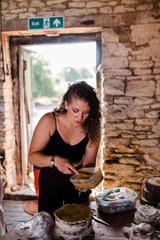
1. Toss your asparagus in olive oil, salt and pepper in a bowl
2. Heat your griddle pan until it’s very hot
3. Griddle/pan your asparagus until its nicely charred and tender, around 5 mins
4. Meanwhile, heat a deep pan with water and a tablespoon of white wine vinegar.
5. Once it’s boiling, make a whirlpool and drop the egg into it. (If you find it tough cracking eggs, get then cracked and into a cup beforehand so you can do this bit quickly).
6. A soft poached egg will take around 3 minutes.
7. Serve the egg on top of the asparagus with another quick grind of pepper and top with an olive oil drizzle and some freshly grated Parmesan

I don’t usually do New Years Resolutions: they never survive January (hello, dark cold nasty days… set up for failure!) but when TheNotAllotmentDad bought me Bokashi bins as a Christmas present it would be rude not to, right?
In the past our family have been pretty good on waste reduction. I am usually the one who starts off with a hare brained scheme to reduce our impact as I am an Eco Worrier (not warrior… author Jen Gale set me straight on that!) and because my MIL brought him up right, TheNotAllotmentDad says “ yes dear” and usually goes along with the Happy Wife, Happy Life mantra He does get the issues with the Climate Emergency, but when you ’ re a teacher with two kids that have additional needs what’s in front of you is your main concern, rather than the greater good
So the Greater Good stuff is up to me, as being a SAHM I have the time to go for it Recycling: check Reducing our plastic? Check Growing your own? The name says it right? check! But we haven’t been so good on food waste, at least for the last year or so Food scraps didn’t quite get to the compost bays on the plot, and the cooked food off the plates (because kids!) never went anywhere but the bin We do have a wormery and they help, but again, cooked waste was not an option there
Also, have I explained that I’m a gardening skinflint? Buying bokashi bran every year sounded like a recipe for disaster in our house and for my bank balance… I’m a one and done buying kind of woman.

However, when someone buys you a present, you use it; it would be rude not to! So January 1st saw us starting our renamed “Takeshi” bin After some DMs with other Bokashi users (thank you GardenGrammers!) I realised very quickly that only cooked waste and cat food scraps were going in with the bran: no way I was going to buy another two bins! In hindsight maybe the week after Christmas wasn’t the best time to start: everyone buys a bit too much extra at Christmas, right? And, although I am usually good at using up leftovers for dinners, things like bread will slip by the wayside. The first week saw me adding way more than I was comfortable with.
The second week had my family scratching their heads and pondering what they had let themselves in for when I announced that we couldn’t have a roast that week as I wouldn’t be able to fit the chicken carcass in the ‘Takeshi’ Lots of muttering ensued: it was obvious that if I didn’t adapt there would be mutiny on the food front in this house! The roast was planned for the following week so the leftovers from the Christmas fridge fillers got used up rather than wasted Mutiny dodged and food waste reduced Win!
Moving ahead to February and March, the same bin was still in use and I was now itching to get to bin two! A large, lidded yoghurt pot took up residence by the kitchen sink for food scraps as I learnt that opening the bin every day is not a good plan: more air means a less efficient bin it seems. I also added layers of delivery card/ paper each week so the pushing down of gooey stinky food isn’t half as messy as it could be. The family have learnt to add said yoghurt pot and bin to the growing list of unknown pots in the kitchen that are not to be touched… I am forever brewing and concocting stuff and they know that if it’s not labelled, don’t open it! We also had two dribbles of Bokashi liquor from the bin which has been heavily watered down and fed to the houseplants which are now all thriving: I’ve never seen so much growth from them in the winter months!
So it’s onward and upwards from here: I’ll be swapping the bins over this week, emptying the now much used compost caddy at the allotment and obsessing over food planning The bins have been reliably lighter going out to the curb, but that may also be due to my current ecobrick obsession I said I was an Eco Worrier, right? More next month!



The weather has not been on our side this winter, the relentless rain and an allotment site that is predominantly clay, it has made for less than ideal working conditions
We have, however, still managed a few gatherings with the home educating families, where play has centred mainly around our potion station and hunting for bugs!
With £500 grant money secured, we have managed to replace 3 of the large rotting beds and create 2 smaller beds The smaller ones should be much easier for little hands to reach into and this means that even the youngest amongst us can get involved in the growing
The plot is really starting to come together, we now have a large area with a big potting bench, perfect for lots of people to get around, the children are excited to get sowing seeds for this year! Myself and the other parents have been busy searching for free seed schemes and we were over the moon to find that the ‘Cultivating Change’ charity were offering out seed packs. A local garden centre had also offered out seed potato bundles, we were very excited to find that not only did we get the seed potatoes but they supplied us with a bag of compost, tools and gloves too! The power of community growing!
Our first dry session of the year saw us creating one of the smaller beds With the frame in place, constructed by one of the other plot holders, we set about making a no dig bed We put a good layer of cardboard down and the children then had fun soaking it and adding a deep layer of compost
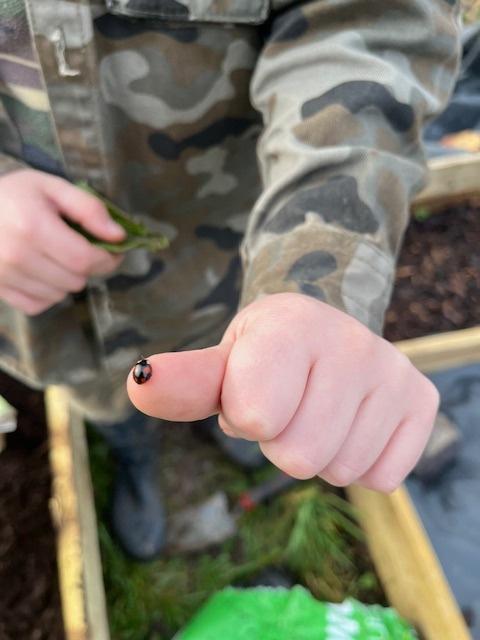
labelling the bed
Whilst the adults were busy with other jobs, we gave the children the task of creating a bug hotel Giving them responsibility for areas of the plot really helps them to feel like they are part of the process It is a way to get them thinking about the insects that would want to use it, what materials they would need to put in it and being able to work as a team We stacked three pallets on top of one another and they then began to fill it, using whatever they could find, sticks, broken bamboo canes, and a bag of straw left over from another project. They even found their first resident, a harlequin ladybird which they gently moved and placed into the relative comfort of the bug hotel.
The plot has not only been used by the home educating families but we are now noticing other allotment holders heading towards the communal plot. When they have a little break from their own work, they will come and relax with other plot holders, the children are free to play, and it is fostering a real sense of community We have plans for a seed swap very soon and hope to encourage more plot holders to use the space for meeting and sharing growing tips with each other We just need a few more sunny days now!

This Month we’re finding out about “A plot amongst the chickens”. A Gardeners World Live Showcase Garden designed by our very own Ben.
Read on to find out more about how his dream is becoming a reality.

Use GARDENS20: 20% off standard adult/concession entry tickets (excl. Saturday) expires 9th May 2024
How it all started
It all started back at Gardener's World Live 2023. It was the first time I'd learned about press tickets and that as a social media content creator, I could apply for a pair of free tickets to the event. So, I thought I'd give it a go and sure enough, I was offered two tickets. I couldn't believe it; I was going to the show! A few weeks later on the Sunday, the last day of the show, my wife and I arrived at the NEC, totally excited about it all and had a wonderful day I spent hours staring at these incredible gardens that had been created, especially at Adam Marshall's beautiful border I was so impressed that someone I knew from Instagram had created this absolutely gorgeous space and had even gone on to win a gold medal for it too! Towards the end of the day, we found ourselves in the floral marquee bagging ourselves all these plants for a quid! It was madness but we couldn't resist a haul at those prices!
Making plans
On our way home, my wife and I chatted and I said that I had this crazy idea I wanted to build a beautiful border that included chickens and an allotment to show how people can do all these things in small spaces She said it sounded great and that I should apply. That was it, the seed was sown! When I woke up the next morning, I'd drawn th most hilarious plan you'd ever see including 'stick chickens' because drawing skills are very limited. It consisted of growing spaces for e chicken enclosure and some flow special at all. I then got hold of th World show organisers and ask chickens and use them in a garden there, before I submitted a design They had to ask all sorts of questions, which made me think it's not been done before but they came back and said yes, design away!
Funding my ideas


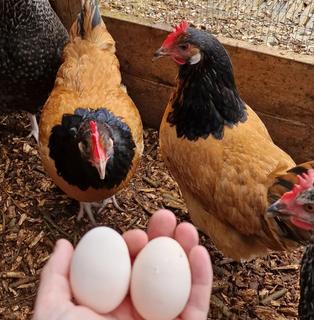
Fitting it all in
I designed chicken tunnels (or chunnels as they're known in the chicken world) to come off from the main run and allow the chickens to explore along the front of the border and give the visitors a close-up view of the girls. I sketched in a couple of vegetable beds and added a compost bin to show that the chicken waste can be used for homemade composting. I imagined terracotta pots of flowers, nasturtiums hanging off the chunnels, fruit trees, and I'd want a seating area all these ideas were flooding my mind It had become this crazy idea that was alive on paper but I couldn't fit it all in I went back to the organisers and asked if I could go bigger and they said yes! By this time, I'd learned that the theme for the gardens was "Share my Space" which couldn't have been more f appropriate for the design I’d created
Making the application
I kept playing with the design and eventually, my wife said "That's it! That's the one!" I wasn't going to argue with her, so one Saturday in early January, I sat at the table all day, with my son ’ s colouring pencils, plenty of coffee and a vision By 8pm that evening, I downed tools and could have honestly cried. I was done! I submitted my drawing, along with my written application and I waited, day after day, constantly refreshing my emails and checking my spam folder. Then one Thursday evening ilst I was cooking dinner, "Ping" an mail came through. My application had been accepted!

A showcase garden
I knew I couldn't afford to build this out of my own pocket, so I wanted to know I had a chicken enclosure sponsor before I even got started. I got in touch with a few but Nestera were the first to take me seriously and really get on board with the potential of this opportunity. That was the moment I knew in my heart, that I could do this
Since then, I've attended a site visit to the NEC and was shown my plot outside. I loved it! Great access, and it has a gorgeous back drop of trees. It was whilst standing here, that I heard a couple talking to an organiser. They were asking if they had to do all this again this afternoon when the beautiful borders designer's turn up. Hang on, I thought, I'm a beautiful border designer, aren't I? So, I asked the question. ‘No Ben,’ came the reply, ‘you're building a showcase garden’ My face must have dropped as I had no idea I knew it wasn't a show garden so asked about a Showcase Garden and it's a bigger version of a beautiful border but with a specific element to showcase: my chickens
I'll be back to give you an update of the progress before the show itself.
By Ben Shutler @plot 27b bristol

It’s not for the faint hearted, but I firmly believe that being outside, connecting with nature, plants and the outside world is good for the minds, bodies and souls of our children The benefits are numerous on every level and fostering a love of the outside world is one of the best things we can gift the next generation.
This beautiful adventure has ups and downs and will test you in many ways It isn’t always easy - what has taken a lot of time and prep to setup can be over in mere moments, crushing your hopes that you had at least a half day activity in the bag.
So, I thought it might be useful to share some of the things I have learnt, in the hope that these may help and encourage others embarking on the same path

In the early days of gardening with my kids, it was a hidden secret I wasn’t sure that my friends were really ‘into it’ and felt a bit uncool This was, in hindsight, bonkers If you don’t have friends who share this passion, find some It’s really easy, there’s tons of online groups and local communities filled to the rafters with people doing the same thing Join them, gardening with children is infinitely better with likeminded people. Also, tell your friends and offer up these kinds of activities. It’s impossible for your mates to get involved if you don’t actually put any of these ideas into the pot when planning days out and things to do.


people 2



Don’t suck the fun from the activity
I have often found it hard to avoid telling my children what to do. “Not like that”, ‘Don’t plant them there” etc. I have got the kids doing an activity with best intentions but then nagged them every step of the way, being surprised at the end when they haven’t enjoyed it and we ’ ve come inside early. The mistake I have often made, is expecting them to do it exactly as I think it should be done. Planting seeds and potting on is a good example of this. Let them have a go, take part and experiment. It might not be textbook but that doesn’t mean it won’t work or be good fun.

Simplicity is king Kids love pouring, mixing, digging and searching and they love to feel that they are contributing If you can tick one of these boxes in an activity you won’t go far wrong Beautifully crafted and setup activities are wonderful, and I see Instagram awash with superb ideas every day, but if you can’t quite get to any of these (I rarely had the brain power on 2 hours sleep) - simple is also wonderful Failing that, bring a hot chocolate outside for extra excitement


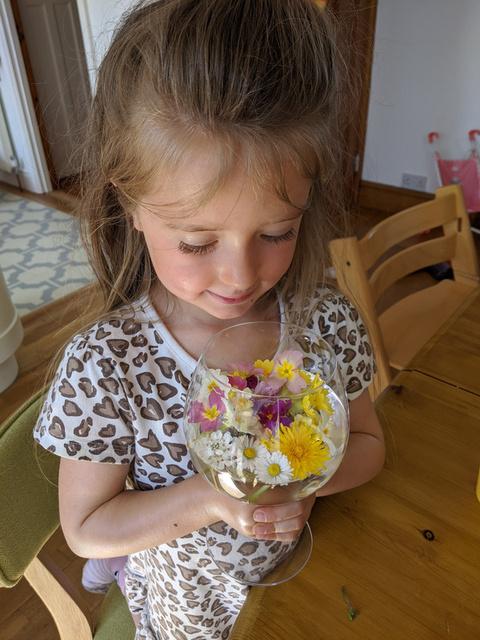 By Jade Pollock @the garden pixies
By Jade Pollock @the garden pixies

Having their own tools, pots and working area is a delight for small people. A mud kitchen, a large tray with pots, their own bucket to collect things in, containers of varying sizes. It can be anything, but if it’s theirs to do with as they please this is usually a winner. I have found the charity shop good for these kinds of supplies (jugs, stainless steel pots, kitchen utensils are all good) 4 5

6
Be prepared... Give children ownership


Pick tasks that are easy for small hands

I have learnt this the hard way Sowing lettuce for example, isn’t terribly easy for a 3-year-old I mean, it’s not terribly easy for an adult either so this type of thing doesn’t tend to bring joy in my experience Broad beans, peas, climbing beans, beetroot, sunflowers seeds - these are larger and tend to be easier for the kids to get involved with It also doesn’t matter too much if they chuck a load in one place as you can usually change them around Make labels (we often colour one side and then write on the other), fill pots with soil, search for leaves, paint stones - these types of activity are your friends.
The kids may eat all your strawberries before they make it into the house. You might be annoyed that they’ve picked the only surviving strawberries, eaten them ALL (without any consideration that you may also like one) and done so in the only 10 seconds you weren’t looking A 5-year-old however is proud that not only did they grow them, they managed to spot and then harvest them independently Try not to be the thief of that particular joyful moment (trust me, it’s hard) They’ll also enjoy cutting your flowers so plant more than you need and go for things that offer up flowers in abundance (Verbena and cosmos are great for this)




Water = fun
There’s a chance that your children might completely drain your water supply making a muddy puddle in the middle of your lawn This is the sort of thing that, like many of the above, can at times test your patience A water obstacle course, where the challenge is to transport as much water as possible through a short obstacle course to fill up a container the other side, is a good and more water efficient game This might be more satisfactory than the lawn muddy puddle scenario - for parents anyway.


I know most people see dandelions as weeds, but to me they are a really important part of the ecosystem They are also really pretty and when they seed it's a lot of fun to blow them and watch them fly away.
Did you know that as the weather gets warmer all sorts of creatures are waking up from a long winter’s sleep? Bees are my favourite. I don’t like them getting too close though; I was stung in the neck once and it really hurt. But bees need our help now; they have used up all their winter stores of honey and are starting to look for food.
Dandelions are a really good early food source so try not to pick them or dig them up and definitely don't spray them with chemicals If you get rid of all the weeds, then there will be less food for the bees
We need to all help save the bees because they make delicious honey and lots of plants rely on them for pollination Without them, we would have less food to eat So, remember to leave the flowering plants for the bees and plant some new ones too

Imogen, Young Folk Champion, says -
I love bees too Nahla and its really great that you ’ re planting flowers to help them and not using any chemicals that might hurt them. I hope lots of people let the dandelions flower so they have plenty of early food.



This month we have teamed up with the hugely talented Celine, Creator of Snakes & Ravens, to offer you the chance to win a one of a kind piece from her stunning jewellery collection
@snakes n ravens Visit Celine’s website

Who is Snakes & Ravens?
I have been an artist for as long as I can remember, but I was always told that I could never make a living out of it. 3 years ago I was without a job and desperate for some money, so I decided to try and sell some jewellery at a local market It was not perfect, but the response I got was good enough for me to keep pursuing it With each month my confidence and skills grew, and I took a leap of faith, creating a brand inspired by something very dear to my heart Nature always has a way of finding a balance within the chaos, and my creations needed to reflect that On one side we have the snake which symbolises the heart: unpredictable, emotional and passionate On the other side, we have the raven symbolising the mind: calculated, logical and wise Together they are my version of Yin and Yang, a reminder to always find beauty in imperfection

I am a huge believer that as long as there is a story, people will care Stories are the reason I knew my pieces by themselves were not enough for me, I needed more And so my ‘Oracle Necklaces’ collection was born These combined the Yin and Yang elements for me, the creation and story, the snake and the raven Each necklace was inspired by a card from the “Woodland Wardens” deck created by Jessica Roux The crystals' symbolism and aesthetic appeal were directly linked to the animal and the plant on the card. Each piece is one of a kind, making it a keepsake for anyone who feels a connection to it. As a bonus, the collector also receives a handmade envelope with the reading and the Oracle card it is inspired by.
I will always strive to create meaningful pieces, and I can not wait to see what more Mother Nature has in store for me. May the Snake & Raven be ever in your favour
From gardening to creating

Through the Covid lockdowns, I needed to get out of the house, watching everything on Netflix simply would not do it for me. I came across a masterclass on gardening by Ron Finley which made it look so simple and satisfying, I decided to give it a go Little did I know it would take over my whole kitchen, backyard and every windowsill in the house It might have driven my housemates crazy, but being connected to nature again and seeing how the smallest seed can yield so much, was incredibly inspiring This inspiration then led me to find wire wrapped jewellery, a technique that heavily relies on organic shapes I would study how the pea plant curled with its organic forms, how the patterns in the leaves all linked together, and how the colours of the flowers complimented each other In connecting these elements I then felt confident to start playing with fire, which brought me on track to become a self-taught silversmith
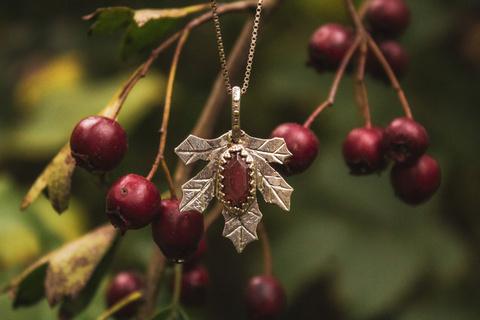



What’s in a name? Well this plant has quite a few of them Have you heard of the chess flower, also known as the frog-cup? More commonly called the snake’s head fritillary this plant in the lily family is native to Northern Europe It may have survived the Ice Age or it may have been introduced to Britain in the 1700s as it was not officially reported to be growing wild in the country before then
Unfortunately, native or not, they are considered to be naturally scarce in Britain because of habitat destruction. There are only a handful of truly wild fritillary sites remaining, predominantly in Oxfordshire where it is now the county flower. Traditionally children here would pick them in large numbers to sell at markets in London. They thrive in damp grassland or meadows but sadly they’ve been labelled an endangered species in other parts of Europe too, thanks to over collection, intensive agriculture, and as wetland areas dwindle.
Their striking, chequered buds look like the head of a snake when closed, hence one of their many nicknames, and their uniquely patterned petals coined the title Guinea-hen flower as well, due to the bird’s spotted feathers being quite similar In Latin the word “fritillus” means dice box A reference to their square shape The fritillary also bares a resemblance to the small bell that Lepers would carry with them in the Medieval period which they rang to warn people of their presence or to seek refuge and charity and so they’re sometimes referred to as ‘Leper’s Bell’ or ‘Leper Lilies’ Interestingly they are occasionally called the Lazarus bell too, potentially because of their shape or because Lazarus (who was famously revived by Jesus four days after his death) is the patron saint of the sick which makes sense since fritillaries can be used medicinally. Their bulbs are said to treat a range of aliments including inflammation, coughs, colds and digestive issues.
These names have also influenced their symbolism as they can be associated with decay and deceit as well as majesty, pride, renewal and rebirth. In fact during the Second World War, fritillaries were planted in demilitarised zones as a sign of peace They were also believed to be magical and were used in spells to ward off evil or bring good luck
Snake’s heads love water but, because they’re bulbs, they dont like it too boggy as they can rot They’re happy in sunshine or partial shade and they’re a great plant for pollinators with their leaves providing food for various moth caterpillars
Have you noticed ‘cuckoo’s boots’ or ‘ crow ’ s toes’ down in the woods? Common or English bluebells have many magical names A native of Northern Europe in the hyacinth family, these 'witches’ thimbles’ are protected in Britain by law due to their decline in the wild It is illegal to remove them from forests or fields where they are growing since half of the world’s bluebells are found in the UK Yet habitat loss, the invasive Spanish variety, and the introduction of species like Muntjac deer have significantly reduced their numbers They are a sign of ancient woodland, and mature slowly, taking many years to become fully established. With the rare white bluebell occurring naturally only once in a hundred thousand flowers!
Patches of bluebells were associated heavily with fairies. They were summoned by the bells ringing and would gather amongst these plants, trapping and abducting any children picking the flowers at the time. They are also connected to sleep. One of their aliases is ‘lady’s nightcap’ thanks to the shape of their petals Walking amongst them (especially at twilight) was believed to cause fainting or enchantment and they were once thought to be a cure for nightmares if placed in pillows or hung near the bed Wearing a wreath of them was said to make you tell the truth These connotations may stem from their ancient affiliation with Endymion who was so beautiful that Selene the Greek goddess of the moon put him into an eternal slumber so that she could adore him forever In the language of flowers they symbolise humility, gratitude, and love Historically, they were used to produce a natural glue This substance could bind books and attach feathers to arrows
Bluebells are great spring plants that provide food for bees, butterflies and hoverflies. They do well in partially shady conditions and like to be watered but not excessively. If you spot them on a woodland walk, try not to step on them as it damages their leaves and hinders growth.
It’s not only important to remember the roots of these plants, preserving their rich history and the sensational stories surrounding them, but also to remember that as native species they support local birds, butterflies, moths and pollinating insects of all kinds They’re beautiful wildflowers that are perfect for indigenous creatures great and small and have been a staple food source for wildlife for centuries Now they need our help to survive So, consider conjuring them into your garden Lets keep the bluebells flourishing and the snake’s head fritillaries thriving for many more years to come





In the last Apothecary Garden article, we discussed making a rose herbal oil from dried roses from our harvests This month we ’ re going to look at some healing ways in which we can use some of our herbal oils
The simplest, and one of the most nourishing and effective way is to use your herbal oils as body oils In contrast to an essential oil, which is a potent plant extract made from one part of the plant; making your own herbal oil as discussed in previous articles utilises the whole plant, meaning you benefit from the myriad of healing properties that each part of the plant provides, rather than use the extract of just one part of the plant.
Using herbal oils as body oils is relaxing and nourishing. They can be massaged directly onto your skin and the benefits can be immediate and long lasting. They immediately calm the nervous system, relax tension and can lessen pain. I strain my oils and pour them into sterilised small roller bottles to carry with me for a quick roll on my wrist when needed, or larger oil bottles with a pipette lid to use at home
A lovely way to use rose oil, and a good way to build your confidence creating herbal products, is to make a herbal lip balm
Rose oil not only smells beautiful, but with its rich concentration of vitamins it is nourishing, calms any irritation and keeps your lips hydrated Other herbal oils that you could use for lip balms are;
Calendula – this would be nourishing and calming Calendula helps heal cuts quickly so would be great to use for chapped skin.
Lavender – this would be ideal if you have sore, irritated lips as it is soothing and helps accelerate cell regeneration.
Chamomile – again this is soothing and with its antiinflammatory properties it would be perfect for reducing any pain in your lips caused by dryness

Make your own Rose oil
You will need :
100ml of your herbal oil
1 tablespoon of beeswax/soy wax/cocoa butter shavings
10 drops of an essential oil of your choice (optional)
1. Warm your oil gently in a bowl over a pan of water, add your wax or cocoa butter shavings whilst stirring continuously
2. When dissolved pour into a sterilised small jar or tin
The balm will harden as it cools
You can buy small tins for lip balm online, but you could clean, sterilise and reuse those small jam jars you can get if you ’ re partial to an afternoon tea or have had a hotel breakfast recently!
We would love to see your herbal creations, so please do tag us – @gardenfolkmag @rainbowdaysallotment in your herbal makes! Happy herbal crafting!


Plants for a dye garden
First off, we ’ ve looked at some of the plants which are going to give us a broad spectrum of colour, so here are a few ideas of what kind of plants you can grow in each colour category Ideally, we’d like to grow a full rainbow of colour in abundance so that we can truly experiment, but the truth is that we don’t have a huge amount of space to work with, so we’ll likely select one or two plants from each category to test out for this year.
Green - nettle, comfrey, sorrel
Yellow - calendula, chamomile, white onions, marigolds
Orange - rhubarb root
Pink/red - beetroot, red onions, marigolds, red cabbage
Purple - red amaranth, blackberries, purple basil, elderberries
Blue - Woad, Japanese indigo
How to fix your natural dyes
Using a mordent can help the colours to become rich and vibrant by helping the colour stick to the fibres, but not only can this process help intensify colours, but also helps them to stay for a longer period of time. This process is something you need to think about ahead of time but is certainly a worthwhile step to ensure you get the best from your natural dyes.
Here are a few mordent recipes you could try:
Soy milk mordant
500 ml of soy milk
2.5 l of water
Use a ratio of 1:5 soy milk: water and add into a large pot along with your fabric. Then leave your pot of fabric and mordant for 24 hours After that, rinse the fabric, either by hand or on a quick spin cycle before hanging out to dry for around a week to cure
Alum powder mordant
Alum powder = to 10% of your material weight
Cream of tartar
Water
Fill a large pot with water and bring to the boil In a separate vessel combine a small amount of boiling water with the alum and cream of tartar until it all dissolves and add it back into the wet pot Add your fabric into the pot and stir occasionally on low heat for an hour before turning the heat off and leaving the material to cool in the pan
How to make natural dyes with a selection of garden plants
Different plants need to be treated differently to get the best out of their colour, here are just a few of the most common ways to extract colour from their corresponding plants.
The salt method - Macerate the leaves of the plant with a spoonful of salt until they turn into a pulp, this will unleash the colour and give you a medium to work with – this method works with woad and Japanese indigo
The heat method - Gently heat your plant material on low The time you’ll need to heat the material will differ from plant to plant, but typically it’s around 30 minutes to an hour This method works for plants such as calendula, chamomile, onion skins, marigolds, rhubarb roots, beetroot, blackberries, purple basil and elderberries
The solar dye method - This is the least intensive method a simply start by filling jars with water and plant material be letting them sit in the sun for a week or so This method w with amaranth and blackberries
We cannot wait to get started in our dye garden this year seeds being sown imminently after the launch of this articl you ’ re going to give natural dyes a go this year, we’d lov from you! Tag us in your stories @thegardenerscocic and #gardenfolkfriends to share your creativity with us.








When will it stop raining? The jobs are now piling up due to the plot being completely waterlogged I have managed to get a few things done though, which felt incredible!
We had a couple of days with glorious sunshine and no rain, which enabled me the opportunity to strim around the Garantia beds. Of course, something went wrong. The strimmer decided to cut out and not start again so I couldn't finish the whole plot. The grass clippings were then added to bay 2 of the compost system.
If you've seen my socials, you'll know I have a huge amount of chicken waste and bedding mix sat in bags against the perimeter fence of plot 40a I finally cleared it! I know, I can't believe it either! To try and get some sort of order and tidy it up a bit, I removed all the bags and added the contents to bay 3 of the compost system This has now removed a huge amount of brown compost material into a single bay Now, I can just shovel this into bay 2 as the layers of green go in
You may remember that in the summer last year, I quickly made a large raised bed with the Alfie & Autumn, so that we could plant out some tomato plants and actually grow something on the plot Well this was only ever going to be temporary, as we didn't really have a plan back then of what we wanted to do. So I scooped out all of the compost and placed it into two builders bags.
My plan is to now create four no dig beds going about half way across the plot I then plan to put the squash arch from last year between the beds and create a multiple arch structure between them all. For now, I have used the plastic bags from all the chicken waste and placed it over the old bed to keep any weeds down whilst I wait for it to dry out a little. Once the ground is more manageable, I'll cut the four new beds, add cardboard to the base and then place the compost back over them.

Spring has definitely made an appearance on the plot, with muscari popping up everywhere, with the addition of even more daffodils adding gorgeous pops of yellow around the trees The damson tree is filled with the most beautiful white blossom, which is a very welcome sight This had a very harsh prune in the autumn as it had not been touched in years and was hanging over both neighbouring plots If these blossoms turn into fruit, we'll be in for a heavy fruiting crop this year
Hopefully, the ground will dry out a little more over the next few weeks and I'll be able to really get cracking with some of the projects that really need pushing on with


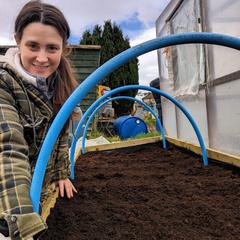 By
By
It’s now all systems go for our flowers here at Life on the Lot, after the first daffodils have bloomed it’s a race against time for the next flowers to be joining them. This year, the second out the starting blocks were the anemones, closely followed by some colibri poppies However, th true showstoppers will be the Ranunculus which are now all in bud and just waitin for their moment to shine
This time of year, I’m eagerly awaiting things to kick into gear! Willing everything to get growing
But to help these things along and get some super strong plants, one more secret weapon has started to wake up – my comfrey!
I use comfrey on all my flowering and/or fruiting plants on the plot I make it into my own organic fertiliser which not only saves me money but provides me with super food for my plants A stinky but very effective way to ensure my flowers bloom right the way through spring and summer!
If you are looking to introduce comfrey to your patch or garden to make your own food, please be advised to introduce the infertile variety Bocking 14. Comfrey is a highly invasive plant that will happily spread and take over. Its very hard to eradicate due to the enormous tap roots which give the plant its super food properties!
For sowing this month, its all systems go! The dahlia tubers are being potted up and ALL the seeds are being sown, and re-sown after the slugs have had their fill!


The Dahlia grow along is well on its way Last months sow your seeds we started off the nig grow along and Ally’s first Dahlia sowing are popping up (see picture above).
If you seeds havent arrive yet they should be arriving with soon ready to get them sown. For all of you joining in Anjee and Ally will be doing a live sow along on 6th April so if you haven’t got sowing yet you can join them then via @gardenfolkmag.
We are so excited to get growing with you so make sure to tag us in all your posts, stories and videos This magazine is all about the community so lets inspire many more people to get growing this season!
Jen Howarth @life on the lot
April is a busy month in the garden. There’s seeds to sow, seedlings to care for, and a whole host of other jobs to crack on with Do try to spend some time enjoying those bright spring days though, we ’ ve waited so long for them!
Things to sow
Flowers
Cosmos
Zinnias
Poppies
Borage
Sunflower
Nasturtium
Dahlia
Edibles
Courgettes and squash
Climbing Beans
Salad Leaves
Cucumber
Squash
Courgette
Sweetcorn
Come and join the @gardenfolkmag team for live sow alongs throughout the month.

This month we ’ re loving the ‘The Skinny Jean Gardener’ Podcast from Lee Connelly, the UK’s Number 1 children’s gardening educator Join him for family gardening inspiration.



Here’s the Garden Folk Mag task list for April to keep you up to date with the job list this month
Check for slugs and snails around seedlings
Prick out and pot on seedlings
Pinch out flowering tips of sweetpeas, fuchsias, snapdragons etc to make bushier plants
Support pea plants
Use cloches or fleece to protect young plants on cold nights
Keep on top of weeds while they are small
Open green house doors and vents on warm days
Deadhead spring bulbs
Pinch out tips of broadbeans (and eat them!)
Start feeding house plants each week and water more regularly
Tie in climbing plants
Repair bare patches in lawns
This month we asked you:
“What are your favourite sustainable tips for the garden?”
Leave seedheads in autumn & winter for birds, save seeds, swap seeds and plants, keep a look out for gardens that are being redone and where they are getting rid of plants, look secondhand, upcyle what you can and get chickens if you can @bluebellandbumblebee
I left rudbeckia and sunflowers over winter to provide food for the birds and shelter for the insects. Last week I cut them down and they have hardened over winter so I will be using them as stakes to support plants in the garden this year.
@star of 72
Save your loo roll cores! They make perfect biodegradable plant pots Summer is the perfect time to start saving those wooden lolly sticks to use as plant labels Save seeds from your veg! Skip dive for bricks, pallets, etc I made my sturdy potting table from an only pallet, a broken bench top, and a fence panel that my neighbour was throwing out! Ask on local pages if anyone has brick, wood etc that they don't want. Ask your local hairdresser to save hair for you and local coffee shops/cafes to save coffee grounds and egg shells - all are fab for your compost heap (and birds will love pinching the hair!)
@agardeningmidwife
Definitely raid your recycling and use in your gardening...seed trays, temporary plant covers...be creative!
@knittingbex
I love learning all the tips I grow mainly with a closed loop watering system vertically which is very sustainable only using 2% of the typical water usage
@makersacreshomestead
Save your rain water doesn’t even have to be a fancy water butt - I use an empty dustbin with the lid flipped and held on with a brick and a small gap and it saves loads! Just make sure it’s there’s an escape route for friends
@plot67
Reuse milk cartons to make seedling watering cans. They are gentler than a regular watering can and great for children as you can make as many or as little holes in the lid as you need
@thewild gardener
Let some of your veg go to seed The flowers are great for pollinators and seed saving is game changing Leave the stems to over-winter for bugs to hide in In the spring just chop and drop, leaving the roots in the soil to aid soil health
@a falling of fingers
Next month we want to know:
I compost as much as i can, from grass clippings, to fallen leaves, kitchen scraps, cardboard boxes and empty loo rolls I also compost all of our chicken manure and bedding, so hardly anything goes to waste Best of all, it goes straight back into the garden once it has turned into beautiful compost
@thegirlgardener
I prefer getting my seeds from friends and exchanges. So I know that the plants can grow in my region, are sustainably sourced and not sterile. It can also help to preserve the diversity of old vegetable varieties
@medeas.garten
So many!!! But the basic is take nothing off but crops. Everything on the plot can usually be reused in some way… you just have to be inventive and be armed with wire, screws, nails and maybe at a push, zip ties Prunings become hedges, supports and now plant protection Grass cuttings become mulch Old tall plant stems can become plant supports and even weeds can become plant food The most useful thing though is somewhere to store all the “ one day” kit!
@theallotmentmum
Compost as much as you can, dont use fertilisers, but make your own from nettles and comfrey, reuse plastic containers for as long as possible, then replace them with non plastic alternatives. Swap, repurpose, exchange, share Lets grow as a community, its not a competition
@thealchemyofgardening
“ How does your garden help your mental health?”
Send us a message on Instagram or email us your answers to info@gardenfolkmag.com


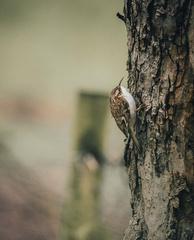



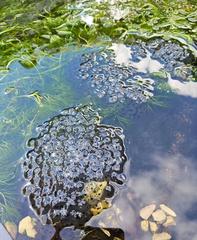
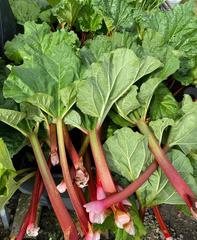
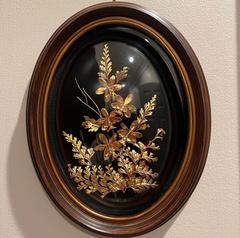














...and help us keep making the Garden Folk Mag
We appreciate all the support given to the magazine by all the Garden Folkour readers, writers, industry supporters and anyone else who cheers us on Running the magazine each month does incur financial costs though, so if you are able to contribute, either with a one off payment or by becoming a member, it would really help to keep the magazine going... and growing.

There are currently three membership tiers to choose from, all with great benefits













Set the date for May 3rd for the next issue
